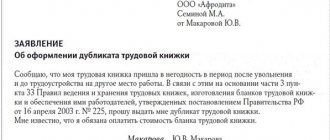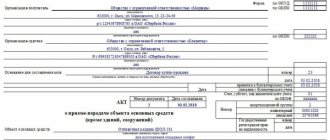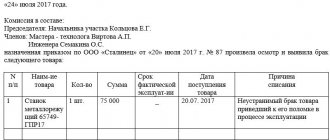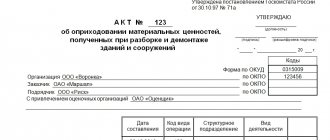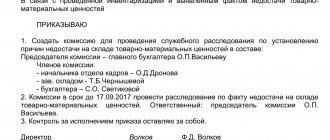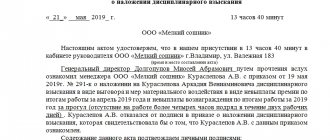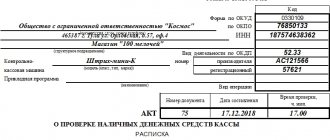Purpose and types of memos
An official memo is an internal document of an organization used in office work for the following purposes:
- to inform colleagues:
- about the performance of any actions by one or another specialist;
- changes in the work process;
- changes in local documentation;
- changes in the composition of information used for production purposes;
- delegation by the manager of tasks to be performed by subordinate employees;
- informing third-party organizations (counterparties, government bodies, etc.) about changes in the existing legal relations between organizations, violations on one side or the other, existing proposals for cooperation, etc.
Thus, the purpose of any memo is to convey information to a specific addressee, and, as a rule, any sample memo serves to encourage the addressee to take some action.
On this basis, we highlight the following main groups of memos:
- about bonuses;
- application of disciplinary action;
- conducting an official investigation;
- write-off of material assets;
- going on a business trip;
- issuance of funds on account;
- providing financial assistance;
- failure to perform official duties;
- conducting an audit of the counterparty;
- the employee’s performance of the assigned task and its results;
- approval of changes in standard forms of documents, etc.
As you can see, any action in production can be formalized using a suitable sample memo. The need to use such a document in the production process is determined by the organization’s local documentation and the company’s established document flow practices.
Shelf life
According to the List of standard management archival documents generated in the course of the activities of state bodies, local governments and organizations, indicating storage periods, approved by Order of the Ministry of Culture of Russia dated August 25, 2010 No. 558, internal memos must be stored in the archives of the enterprise for at least five years. If necessary, the director of the organization has the right to extend the storage period. The storage period for documents issued electronically may be determined by the company's charter.
How to write a memo correctly: regulatory framework
At the legislative level, there are no approved requirements for drawing up a sample memo. As we have already indicated, such a document is drawn up in accordance with the internal rules of the organization.
Theoretically, office work may not involve documents of this type. However, in practice this is extremely rare. Drawing up a memo is also an act of recording the actions taken by the compiler of the memo, which in some cases can act as evidence of the proper performance of his job duties by such a person (for example, the decision of the Avtozavodsky District Court of Tolyatti dated May 24, 2018 in case No. 2-2-1852/2018, etc.).
You can find more complete information on the topic in ConsultantPlus. Full and free access to the system for 2 days.
When writing a memo, you can take as a basis, for example:
- GOST 7.0.97-2016 “National Standard of the Russian Federation. System of standards on information, librarianship and publishing. Organizational and administrative documentation. Requirements for the preparation of documents”, approved. by order of Rosstandart dated December 8, 2016 No. 2004-st;
- GOST 7.0.8-2013 “National standard of the Russian Federation. System of standards on information, librarianship and publishing. Record keeping and archiving. Terms and definitions", approved. by order of Rosstandart dated October 17, 2013 No. 1185-st;
- GOST R ISO 15489-1-2007 “National standard of the Russian Federation. System of standards on information, librarianship and publishing. Document management. General requirements", approved. by order of Rostekhregulirovaniya dated March 12, 2007 No. 28-st, etc.
These GOSTs can also be used in the development of various local regulations and recommendations for the preparation of documentation in a particular company, although this is not required by law.
The reader will find a sample of how to correctly write a memo, available for download, below.
How to apply?
You can prepare an official business paper either in written or electronic form. When writing the first variety, you must use the rules described above.
In relation to the service letter, its version in electronic form must be written in the same way as the one compiled in writing by hand.
There will be two exceptions:
- the addressee is not specified, due to the fact that the recipient will be the user to whose email address the note was sent;
- identification of the sender also occurs thanks to the details of the email address of the official who sent the document. The addressee's signature can also be affixed automatically.
After sending an electronic version of a document, you need to request confirmation of its receipt, which, under certain circumstances, can prove the time of sending.
Writing example
Accounting to the Head of the information technology department of TsNBTI LLC
SERVICE NOTE
about the need for computer repair
10/01/2016 No. 4 Pushkino
I would like to inform you that over the past two weeks, the computer assigned to payroll accountant Lyudmila Petrovna Timchenko has been experiencing systematic malfunctions. The computer has been in use since March 20, 2013 and has been repaired once.
In connection with the stated facts, I ask you to repair it or replace it with a similar one.
Deputy Chief Accountant Vivdich D.I.
Read more about when you need a memo about a malfunction, for the purchase or replacement of a computer, and how to draw it up based on the sample.
You can write a memo further.
How to correctly compose and fill out a memo form
If the organization has an approved sample memo form, it is recommended to use it.
If there is no such form or it is necessary to develop rules for its preparation, you can rely on the recommendations of GOST (for example, section 4 “Document details” GOST 7.0.97-2016) and the general established practice of office work.
So, any sample memo usually has the following structure:
- Addressee (full name, position, name of structural unit, name of organization).
- Date of preparation.
- Place of compilation.
- Title of the document.
- Information about the employee who compiled the document (full name, position, name of structural unit, name of organization).
- The subject of the memo (for example, “on conducting an inspection of ... (name of the counterparty) for the purpose of concluding a supply agreement”, etc.).
- The text of the memo containing an order or other information addressed to the relevant person. The memo often also includes material and technical justification for a particular action if the provision of any material assets is required.
- Attachments (calculations, acts, list of necessary material assets, counterparty documents for verification, estimates, photographs, witness statements, other official memos, new editions of documents, etc. - in accordance with the content of the memo and the required actions of the addressee);
- Compiler's signature.
In cases determined by local documentation, the memo may also provide for a visa for the immediate supervisor of the originator of the memo or other departments (for example, the legal department, accounting, financial monitoring service, etc.).
So, we have looked at how to draw up a sample memo, let us now dwell in more detail on the form of such a document.
Document requirements
The algorithm for registering a disciplinary violation is contained in Art. 193 Labor Code of the Russian Federation.
We invite you to read: Letter of guarantee for employment of a convicted person on parole
The first step is to document the fact of the offense. For example, the fact of being late can be proven by a time sheet or a memo from your immediate superior. The purpose of the document is to inform the head of the enterprise about what happened and encourage him to take corrective action against the negligent employee.
The memorandum is transmitted to the employer through the secretary. It should be recorded in the incoming correspondence log.
After receiving and reviewing it, the director may decide on further proceedings.
In the list of primary accounting documents used by government agencies, determined by Appendix No. 1 of Order No. 52n of the Ministry of Finance of Russia dated March 30, 2015, there is no unified form for drawing up this paper. It is written in any form on a blank sheet of A4 paper. If necessary, in an organization with a branched structure, it is possible to develop this form.
The sample memo form contains details that allow users to quickly orient themselves to the essence of the document, its source, relevance of date and serial number. This document is not subject to mandatory registration. But an organization may decide to register them, for example, for control purposes.
An internal memorandum is an official document adopted in the company’s internal document flow. Compiling it correctly is important for setting up successful communication. The recipient must clearly understand what the sender wants to tell him. To do this, the document must indicate the following points:
- Exact numbers (for example, salary, bonuses).
- Dates (for example, the date an employee was sent on a business trip).
- List of grounds for the measures specified in the memo.
- A list of material objects that are present in the sender’s request.
- Information about all persons who appear in the note.
The note begins with a “header”, which contains information about the persons participating in the communication and the name of the organization. You also need to register information with the company. At the end of the note, you must indicate the date, signature and its transcript.
Recently, official memos have been practiced, which are sent via e-mail. However, the classic option is written drafting.
We can say that drawing up such notes is a way of communication between employees of the same level. For example, they can be sent from the head of a department to the general director. Usually the head of a department asks for his employees. If ordinary employees write a note, it will be considered a report.
Memo form
The law does not establish a requirement to use official notes in office work at an enterprise. Each organization determines when this is necessary.
Based on the wording itself, it is clear that the form of the memo is written. In practice, a memo can be issued:
- by hand on paper;
- by typing text in electronic form with further printing on paper and a handwritten signature of the compiler;
- using special software that allows you to register documents and sign them with the user’s electronic signature.
The use of electronic document management, among other things, makes it possible to accurately record:
- date and time of drawing up the memo;
- its author;
- date of dispatch to the addressee and acceptance for work;
- as well as other stages of its implementation.
Regardless of the chosen form of the sample memo, its contents usually correspond to those indicated above.
The legal significance of the memo also does not depend on the chosen form of the document. In this case, the fact of the reliability of the transmission of the information contained in it and the timely and proper sending to the addressee is of decisive importance.
For example, an authorized employee sent memos about shortages to the general director by email, which the latter did not receive because, according to him, he did not use email. According to the court, the sending of the above memos cannot be regarded as the taking of effective measures on the part of this employee to establish the causes and eliminate the shortage and be the basis for his release from criminal liability (see the verdict of the Novokuybyshevsky City Court of the Samara Region dated 09/07/2015 in case No. 1-2/2015).
How to write a report on the removal of a disciplinary sanction?
Legislative and legal acts do not limit the right of employees, depending on their position or profession, to contact management with a report.
In practice, issues related to labor relations are resolved in the order of subordination. Employees write statements and memos explaining to their immediate superior. Next, the information is brought to the attention of the first manager.
At the same time, for example, with a complaint against the director, each employee has the right to write a report to a higher organization.
https://youtu.be/BVRH7z_NHpM
Example of writing a memo
Above, we examined the main cases and rules for drawing up official memos, and now we invite the reader to use the universal sample of an official memo that we have compiled, which can be downloaded from this link: Official memo - sample.
Memos usually act as a means of communication between employees of a department or various departments within an organization.
Also, memos can be used for communication between different organizations. Typically, such memos are called external, although, in fact, they can be considered, among other things, commercial offers, complaints, notices, etc.
Questions about business correspondence between counterparties are covered in more detail in other materials on our website, for example:
- “Sample letter of claim for non-compliance with the terms of the contract”;
- “Letter from the supplier about the delay in delivery of goods”, etc.
What points does it consist of?
There is no single template for writing memos, so they are compiled in any form. Rules to follow :
- indication of the addressee;
- Title of the document;
- date and serial number;
- subject of the note;
- the main part provides a description of the situation and formulates the request (and/or the intentions of the department head regarding the offending employee);
- Below is the position of the compiler, his signature and its transcript, and, if necessary, full name, first name, first name, and signatures of other team members who can confirm the fact described in the document.
The “header” can be placed in the center of the document or attached to its edge.
Since the note is a tool for business correspondence, it should be written in an informational and business style.
The problematic situation is described without unnecessary words and complex speech patterns: concisely, succinctly and to the point. The service note is registered in a special journal . The journal is usually located in the secretariat.
Read more about the rules for preparing official memos in accordance with GOST, as well as what requirements apply to their writing here.
Office and memo: differences
Since there is no legislative regulation regarding the preparation and use of official memos, it is not possible to clearly say where the line between an official memo and a memorandum lies.
Typically these terms are used with the following meanings:
- An official memo is a document that informs or warns another person (for example, a colleague or group of colleagues) about a particular fact relating to production activities, or serves to delegate an order from a superior to a subordinate.
- A memorandum is a document intended to notify authorized persons of accomplished facts of violation on the part of officials of an organization (including a third-party organization that is a counterparty of this company) or containing any question with the conclusions and proposals of the compiler. Memos, unlike official memos, are sent to higher management (official memos are usually intended for officials, regardless of their status in relation to the executor of the memo).
However, such a difference in the terminology used is not fixed in any official acts, therefore their replacement when used in office work does not have any legal significance: the legal meaning of a document is determined based on its subject, actual content, and not the title (by analogy, see clause 5 of the resolution of the Plenum of the Supreme Arbitration Court of the Russian Federation dated March 14, 2014 No. 16).
In addition to this terminology, in certain areas of activity other names may be used to designate similar documents, for example: report, information letter, certificate, petition, etc.
Standards for regulating the legality of a document
There is no mention of this document in OKUD OK 011-93 (All-Russian Classifier of Management Documentation), but in documents on labor law there are references to an internal memo, along with a report.
Recommendations on how to draw up a report (similarly, an internal memo) were included in Federal Law No. 184 of December 27, 2002. Its latest edition contains changes and additions regulated by Federal Law of April 5, 2020 No. 104.
The main difference between a memo and a memo is that the first of them provides management communication between the heads of equivalent structural divisions, i.e., management at the horizontal level. The second note provides a vertical level of control.
How to write a memo about violation of labor discipline
One of the most common types of memos (reports) is a memo about violation of labor discipline. The general procedure for drawing up such a memo is similar to what we discussed earlier, but in this case there are also some nuances.
There are no legislative requirements for the content of this type of document, but on its basis an order is subsequently drawn up to impose a disciplinary sanction on the employee (see article “Order to impose a disciplinary sanction”). A mandatory requirement is that the order must indicate clear grounds for applying such measures to the employee. Accordingly, the memo should specifically indicate:
- which employee committed the disciplinary violation;
- what specific job duties were violated;
- at what time and date the specified disciplinary violation was committed.
Thus, the court indicated that not only from the order itself, but also from the corresponding memorandum, it is not clear what disciplinary actions and when exactly the employee committed, therefore the application of disciplinary measures against him cannot be carried out (see the decision of the Khostinsky District Court of Sochi dated June 20, 2011 in case No. 2-1114/2011).
In his report, the manager of the employee who committed the disciplinary violation may also indicate the type of disciplinary liability to which he proposes to subject such an employee. However, another situation is also possible when the manager, on the contrary, requests that such measures not be applied to the offending employee.
A sample - how to write a memo about a violation of labor discipline - is posted below: A memo about a violation of labor discipline - a sample.
Writing Instructions
Disciplinary action may be imposed for a number of reasons. How to correctly write a document about disciplinary action?
Violation of labor discipline
A document on violation of labor discipline confirms the fact of violation:
- internal regulations;
- rules of the organization;
- norms of the Law.
He informs his superiors that any of the employees are irresponsible in their work.
Failure to comply with these points may be partial or complete, intentional or unintentional, which must be taken into account when drawing up a memo.
Approximate compilation algorithm:
- name and position of the responsible person;
- in the first line - the main heading “Office memo”, in the second line – the subheading “about violation by an employee (full name and position) of labor discipline” or “about failure (full name and position) of official duties" ;
- main part: description of all facts indicating a violation (if there are several of them, it is advisable to divide the text into paragraphs);
- ending: contains suggestions regarding penalties that can be applied to a negligent employee;
- at the bottom of the document is the current date of writing, full name. and the signature of the official who compiled the document.
The basis for the penalty may be a memorandum, an act of violation, or a decision of the commission on the employee’s involvement in causing damage to the employer.
You can find out how to properly prepare a memo, as well as see a sample document, here.
About disciplinary action
An official letter about the imposition of a penalty is drawn up after recording the fact of violation of labor discipline, taking into account the previous official memo, as well as the explanatory note received from the employee who committed the misconduct. The document indicates to whom, for what and on what basis the penalty was imposed.
Approximate compilation algorithm:
- the name and position of that person. to whom it is addressed;
- the heading “Official memo” and the subheading “on imposing a penalty” (full name and position of the employee who violated the employment contract) in the genitive case;
- the basis for drawing up a note (act, report, commission decision on the employee’s involvement in causing damage to the employer in a brief summary) indicating the clause of the employment contract that was violated;
- how the employee will be punished;
- date of writing, full name and signature of the official.
About its removal
Very often, an employee who has received a penalty, but values his work, no longer commits similar violations and works well. In this case, the immediate supervisor may change his decision and draw up a memo requesting higher management to lift the disciplinary sanction from the offending employee.
A note on the lifting of a disciplinary sanction is written arbitrarily in the name of the main manager of the organization who imposed it on the employee.
Approximate compilation algorithm:
- name and position of the person. the head of the organization;
- the name and position of the head of the department composing the note;
- document's name;
- reference to the order of disciplinary action with a date;
- arguments in favor of the employee and reasons for canceling the penalty;
- final request to interrupt the collection ahead of schedule;
- date of preparation of the official document and signature with transcript.
Service memo on write-off of material assets
This type of memo is required in cases where it is necessary to write off broken down or obsolete (technically or morally) property used in production activities, lost or damaged valuables on the organization’s balance sheet, etc.
An example of a memo can be downloaded here: Memo on writing off material assets - sample.
This document should indicate:
- what specific material assets are subject to write-off;
- in what quantity;
- on what grounds;
- in what time frame;
- Is it necessary to replace such material assets after write-off with others, and if so, what kind?
If there is reason to believe that damage or loss of material assets occurred due to the fault of employees, at the same time in this memo you can indicate the need to conduct an internal investigation (see article “Procedure for conducting an internal investigation”).
Such a memo is usually written to the head of the organization, who can later assign it for execution to the relevant department in the company or reserve the execution for himself.
For what incidents is it compiled?
There is no specific list according to which work needs to be compiled: employees do this at their own discretion. They are usually written after facts of an employee’s failure to fulfill their job duties have been revealed, or gross violations of discipline have been committed. Usually no one reports about minor violations; attention is simply focused on this. For failure to fulfill duties, the manager has the right to issue the employee a warning or reprimand; for gross violations, the sanctions can be much more serious, including dismissal. Let's look at the list of gross violations (they are specified in labor legislation):
- Being at work under the influence of drugs or alcohol.
- Absence from work for more than 4 hours in a row without a valid reason (so-called absenteeism).
- Damage to property owned by the company, embezzlement or theft of employee/company property.
- Various violations in the financial sector, abuse of trust, failure to provide necessary information about oneself. An employee holding a responsible position (for example, a security officer or an official) may hide information that he has real estate or accounts in foreign banks, which entails undermining trust in the employee.
- An employee, without a good reason, does not want to fulfill his work and official duties.
- The worker refuses to undergo a medical examination (applies to some positions and professions, usually related to catering and working with people).
- The worker has not passed safety certification or has not received the documents necessary for work (for example, a medical certificate for drivers, permission to work with a certain voltage for electricians, etc.).
It is permissible to write a written statement both in case of violation of the rules established by the labor code and those in force at the enterprise (provided that upon employment the employee agreed to comply with them). That is, if a company has introduced a dress code, and some people regularly violate it, then reasonable sanctions may be applied to them. Or, for example, the enterprise has a requirement to ban smoking outside designated areas, but someone smokes in the workshop, violating fire safety rules.
The corresponding act must be attached to the report
https://youtu.be/dymif-ZcwGg
Who reports poor performance?
Office memos are a form of internal document flow of an organization, therefore such paper can only be drawn up by employees of a given enterprise. A memo about failure to fulfill official duties is a clerical form of transmitting information “bottom-up”, in which lower-level employees notify their superiors about the attitude of colleagues to work, as well as events in the company that require management to be aware of.
If a subordinate does not respond to the instructions of the manager who supervises his work, the immediate supervisor can draw up a “memo” for the employee who is not doing his job. The report is addressed to the employer who hired this employee.
In the event that ordinary employees are dissatisfied with the distribution of labor efforts in a team, they can complain about a colleague in an individual or group report written to their immediate superior or senior management. This document is also a version of an internal memo informing management about the state of affairs.
Samples of memos. Memo to an employee
This means the following:
- he denies the fact of its commission;
- does not admit responsibility for what happened;
- doesn't want to talk about this situation.
In this case, the employee draws up a refusal in writing.
It consists of the following components:
- “hat” in the upper right corner, where the addressee is indicated - the manager;
- title: “REFUSAL TO GIVE A WRITTEN EXPLANATION”;
- description of the incident;
- listing the reasons for your reluctance to provide written explanations;
- date of;
- signature;
- transcript.
Based on the refusal presented, the employer draws up an act recording the receipt of this document from the employee.
Based on this, he has the right to apply disciplinary action.
A memorandum as an internal document has certain principles of drafting, depending on its purpose. We will reveal exactly how reports should be drawn up in certain work situations.
There are three different sample memos for an employee to choose from.
The legislation does not distinguish certain types of official information, therefore you will not encounter the term “memorandum” in the texts of such regulations as the Labor Code. This is a certain “internal code” used for the convenience of transmitting information between different members of the same organization, along with official and explanatory notes.
OKUD report number – 0286041
Specifics of the report
This type of official information, unlike other types of notes, is addressed exclusively to higher positions, authorized persons, superiors - that is, people who make real decisions. The information contained in such a note is precisely intended to bring to life some kind of action, which one depends on the purpose of the report and the information and proposals contained in it.
The report is intended to convey information “vertically”, and the memo transmits information between employees of equal status. Unlike a report, a memo is not provided for by OKUD. Written by the employee of his own free will.
We suggest you read: How to decipher sick leave
The explanatory note is also sent “vertically”, but is fundamentally different in the purpose stated in the very title of the document: to explain this or that current situation in order to resolve the issue of the employee’s guilt or innocence. That is, as in the report, a representative of a higher position is encouraged to make a decision, but this decision concerns only disciplinary violations. OKUD has its own code, just like the report. Written at the request of management.
NOTE! The memorandum, depending on the circumstances, can be written on one’s own initiative or at the direction of authorized persons. This document has legal force.
The main purpose of reports is to inform management and encourage further action. The specific functions that a memorandum can perform may be different:
- resolving a problem of a production or administrative nature;
- rationalization proposals for improving production activities;
- conveying to management an opinion on the decision made (most often this is how disagreement is expressed);
- explaining your position in the event of a conflict with colleagues or immediate superiors;
- regular progress reports;
- complaints in case of employees’ refusal to carry out the orders of their immediate superiors;
- proceedings regarding improper delegation of responsibilities;
- bringing to the attention of management information about violations of labor discipline and regulations;
- information about incidents that resulted or could result in material loss or physical harm;
- positive aspects that require management's reaction.
If we consider this type of official documentation from different positions, we can identify several of the most frequently used types of reports.
- Content. Depending on what information the report contains, we can distinguish:
- informing - conveying to the authorities the information necessary for making a decision, for example, about the progress of work, about the nuances that have arisen, and methods of action; as a rule, submitted regularly until the completion of the project;
- reporting – reports on the completion of any stage of work to receive further instructions and, if necessary, normalize the situation;
- proactive - the author makes his proposals based on the information he provides.
- Destination. Its type depends on who exactly the report is sent to:
- external - sent to the management of another institution;
- internal – addressed to higher-ups within the organization.
- Data. Information brought to the attention of management that requires immediate action is often negative. But it happens that you need to notify your superiors about the employee’s special successes. The type of report depends on the situation described in it:
- violation of labor regulations and discipline;
- failure to perform or insufficient performance of official duties;
- allowing insults to honor and dignity, unacceptable behavior, provoking conflicts;
- outstanding achievements worthy of awards, etc.
FOR YOUR INFORMATION! Internal and external reports are characterized by a significant difference in design: for the latter, the organization’s form is required.
Author of the report
Theoretically, any employee of the organization has the right to write a memo. In practice, when presenting it, the principle of subordination is observed. The head of a structural unit writes a report addressed to the general director.
Subordinate employees must resolve situations that arise first with their immediate superiors. And if it deems it necessary, it will bring the information to the attention of the management.
The exception is the case when the memo is drawn up in connection with a complaint against the head of the structural unit himself. In such cases, any employee can directly appeal to senior management.
Regardless of what type the report belongs to, there are certain points in the structure that must be observed. As a rule, a report can be divided into three independent parts.
- Facts, events, reasons that prompted you to write a report. This part should give the reader an answer to the question “What happened?”
- The author's thoughts on the current situation, his suggestions, options for possible solutions.
- Conclusions and recommendations of the author of the note.
Like any business document, a memorandum must fundamentally comply with the requirements set out in GOST 6.30–2003 “Unified documentation systems. Unified system of organizational and administrative documentation. Documentation requirements."
IMPORTANT! If this document is drawn up incorrectly, it may be considered legally unreliable and, thus, will lose the force of evidence when resolving controversial issues.
The internal memorandum can be written or printed on a regular A4 sheet. No special form is required for this. Details that are accepted for this type of internal documentation:
- the name of the unit addressing the note is located in the upper left corner;
- the recipient of the note - his full name (initials are enough) and position must be indicated in the upper right corner;
- the title of the document in capital letters in the middle of the sheet - REPORT NOTE (location on the left edge of the sheet margin is allowed);
- below is the date in the format dd.mm.yyyy in Arabic numerals - this is the day the document was signed;
- short summary of the report;
- content in three separate blocks;
- on the last line the signature of the author is placed with a transcript and the title of the position.
An external memo is an outgoing document. It must be drawn up on the organization’s letterhead. In addition to the information listed above, the external report must contain the following information:
- information about the sending organization;
- number assigned to the document;
- the city in which the report was compiled;
- subtitle (written below the title of the document and begins with the words “Regarding...” or “About...”).
The remaining elements - the title of the document, the addressee's data, the text of the report, the signature of the author - are drawn up in the same way as in the internal report.
Recipient's reaction
Having received the memorandum, taking into account the facts stated in it, the manager makes a certain decision. He expresses his will in the form of a resolution, which he places on a sheet of paper with the text of the memorandum. This resolution is the basis for implementing the decision.
Practice has established several types of reports that are most often found in everyday life of organizations. Let's look at their features and give examples of their composition.
Such a document is an official confirmation of the employee’s disciplinary offense. In order for a disciplinary sanction to be imposed on him, management must be notified of the violation. This is why this type of report is used. It contains information about the offense and a request to take appropriate action.
Example of a report on violation of labor discipline
https://youtu.be/SqgREI3Vr5M



